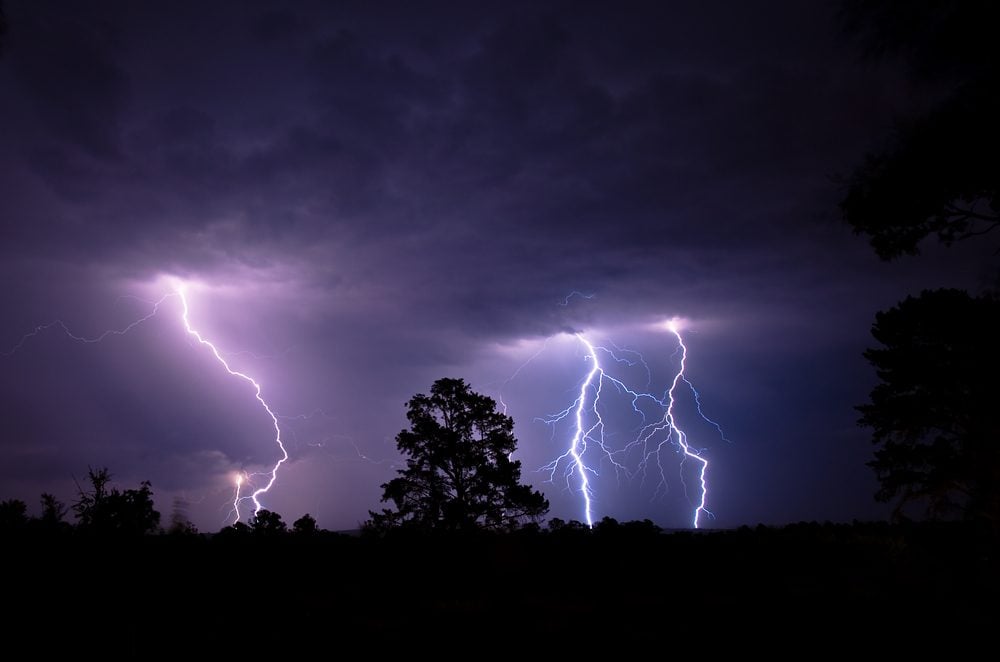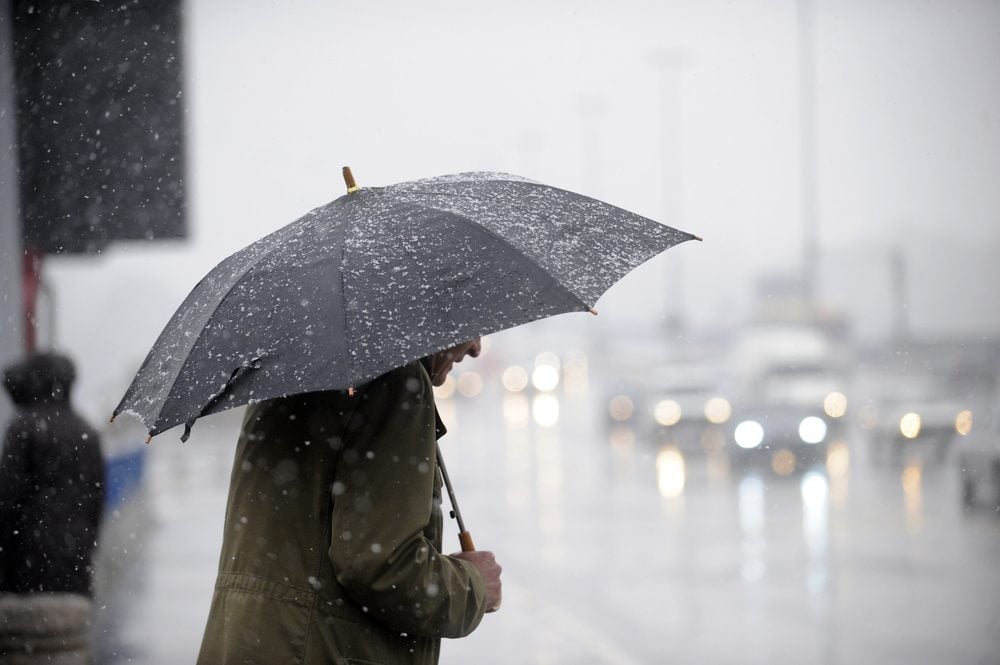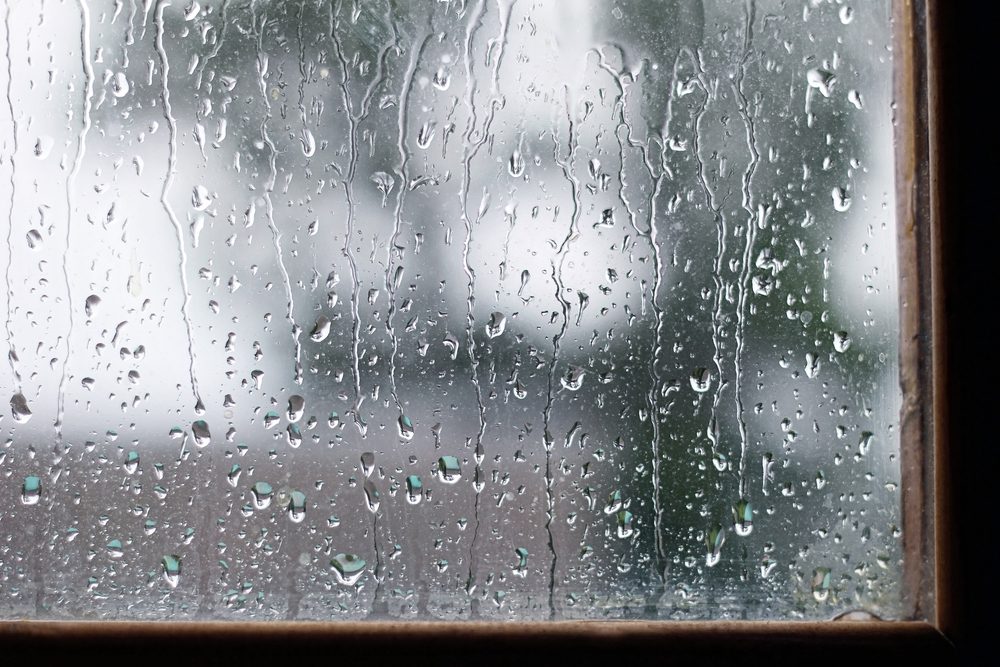
Take a shower
In the case that lightning strikes your house during a thunderstorm, taking a shower can put you in danger. If your house gets hit by lightning, the U.S. Centers for Disease Control and Prevention (CDC) confirm the bolt can travel through metal water pipes and electrify you in the shower, or even if you wash your hands.

Stand under a wooden object
John Jensenius, a lightning safety specialist at the National Oceanic and Atmospheric Administration, told Business Insider that standing under a tree is considered an “extremely risky” place to be during a thunderstorm. Depending on where you are, trees are likely the tallest object around and will be hit by lightning before you. However, the lightning can jump from the tree to you because humans conduct electricity better than trees. With that said, you should probably avoid standing under or near any other tall wooden objects.
Psst—this is the rainiest place in Canada.

Stand in the open
Though you might be afraid to stand under a tree when there’s lightning, another thing you should never do during a thunderstorm is stand outside in the open. The CDC advises avoiding open places like porches, gazebos, golf courses, and parks. As soon as you notice thunder or lightning, you need to get inside as quickly as possible.

Touch concrete structures
Concrete walls, floors and buildings tend to have metal wires or bars through them. To keep lightning from striking you, don’t stand near or lean on these concrete structures.
Take a look back at the worst tornado in Canada’s history.

Lie down
Lightning strikes the tallest object first, so it would make sense to make your body the smallest object around, right? That’s correct, but one thing you should never do during thunderstorms is lie down on the ground. The CDC says that even at 30 metres away, the electric current from lightning that runs on the top of the ground can still be deadly. The best way to make yourself small is to crouch down in a ball-like position with your head tucked and hands covering your ears.
Here’s what to do in a power outage.

Go outside directly after a thunderstorm
The CDC’s “30-30” rule says that if you’re outside and see lightning, you should start counting to 30. If you hear thunder before getting to 30, then you need to go inside. But when do you come back outside? Keeping with the rule, the CDC recommends waiting at least 30 minutes before heading outside again after a thunderstorm.
Don’t miss this gorgeous gallery of rainbow photography.

Use a corded phone
Not many people use corded phones these days, but if you still have one in your home, the CDC says you shouldn’t use it during a thunderstorm. You shouldn’t even use your laptop or other electrical appliances because lightning can travel through electrical systems and zap anything connected to an outlet. Definitely don’t try unplugging devices during a storm either, as that’s also increases your risk of electrocution. The safest way to contact someone during a storm is to use a smartphone—just make sure it’s not plugged into the charger.
Follow our healthy home checklist to eliminate potential hazards in every room.

Waste time removing metal
Metal conducts lightning but won’t necessarily attract it, according to the National Weather Service. If you’re outside during a thunderstorm, don’t spend time trying to remove any metal that you’re wearing on your body, like belts or watches. Your main concern should be getting inside to safety, avoiding metal fences, railing, and bleachers along the way. However, the CDC says that you increase your chances of being directly hit by lightning if you carry a conductor (i.e. something made of metal) above shoulder level.
Here’s why Calgary is the hailstorm capital of Canada.

Be afraid to help someone who got hit
One myth that the National Weather Service has busted is that a lightning victim is electrified and can shock others. Human bodies cannot store electricity, so if you come in contact with someone who got struck by lightning, you won’t be electrocuted. If you find yourself near someone who got hit by lightning, don’t be scared to give him or her first aid help. You could save a life!

Stay in a huddled group
Another thing you should never do in a thunderstorm is stay close to your friends or have people near you. By separating from a group of people, you can lower the amount of people who are at risk of being hurt by ground currents and side flashes between people.
Put your emergency response skills to the test with our first aid quiz.

Leave your pet outside
Keep your animals safe during a thunderstorm by bringing them inside. Having your dog chained to a tree is just as dangerous as if you were to stand under a tree. Doghouses aren’t safe for your pooch either, especially those made out of wood. Being inside is the best option for everyone in your family.
Check out these natural disaster survival tips from a Red Cross volunteer.

Stand near a window
You might be inclined to sit near a window during a thunderstorm to witness a bolt of lightning come down from the clouds, but that can be extremely dangerous. Windows and doors that may contain metal parts can conduct electricity, leaving you at risk of being struck if you stand too to them or electrocuted if you touch them. You want to be as close to the inner part of your home as possible during a thunderstorm.
Don’t miss this expert advice for driving in the rain.

Touch anything wet
The National Weather Service explains that water, like metal, doesn’t attract lightning, but it can conduct it. If you touch anything wet or are in water, you put yourself at a high risk of being shocked. Always remove yourself from the pool, lake, or any body of water during a thunderstorm.
Next, find out what happens if you get struck by lightning.